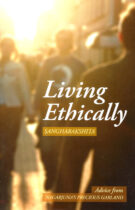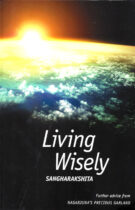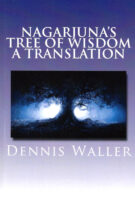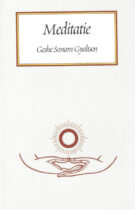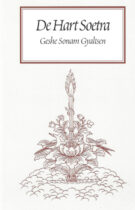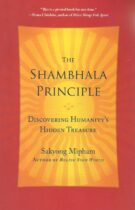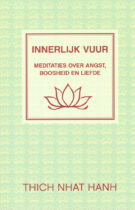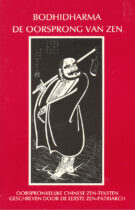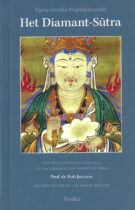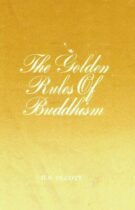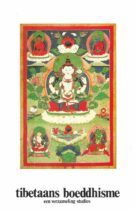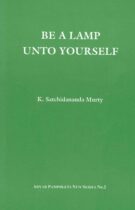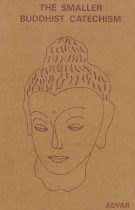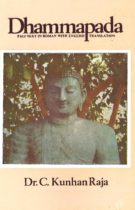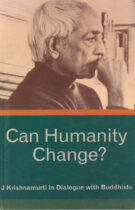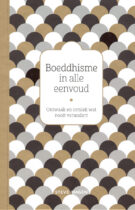Living Ethically – Advice from Nagarjuna’s Precious Garland
Door Sangharakshita
202 Pagina’s | 2009 | Softcover | Uitgeverij Windhorse Publications | ISBN 9781899579860
In een wereld waar steeds meer sprake is van een verwarde ethiek kijkt Living Ethically terug op de eeuwen heen voor begeleiding van Nagarjuna, een van de grootste leraren van de Mahayana-traditie. Op basis van de thema’s van Nagarjuna’s beroemde geschrift, Precious Garland of Advice for a King, verkent dit boek de relatie tussen een ethische levensstijl en de ontwikkeling van wijsheid. Sangharakshita behandelt zowel persoonlijke als collectieve ethiek en beschouwt duurzame thema’s als trots, macht en zaken, evenals vriendschap, liefde en vrijgevigheid.
Sangharakshita (1925-2018) was de oprichter van de Triratna Boeddhistische Gemeenschap, een wereldwijde beweging. Hij heeft een leven lang lesgegeven en geschreven en is nog steeds Triratna’s belangrijkste leraar en gids.
Living Wisely – Further advice from Nagarjuna’s Precious Garland
Door Sangharakshita
128 Pagina’s | 2013 | Softcover | Uitgeverij Windhorse Publications | ISBN 9781907314933
Hoe leven we verstandig? Dit is de brandende vraag die Sangharakshita probeert te beantwoorden in dit tweede deel van zijn commentaar op de beroemde tekst Precious Garland of Advice for a King. Het advies is dat van de grote Indiase boeddhistische leraar Nagarjuna. In het eerste deel, Living Ethically, liet Sangharakshita ons zien dat we, om een boeddhistisch leven te leiden, een ethisch fundament moeten ontwikkelen: leven op een manier die in toenemende mate wordt gemotiveerd door liefde, tevredenheid en bewustzijn. Vanuit boeddhistisch oogpunt is ‘goed zijn’ echter niet goed genoeg. We moeten onze positieve ethische positie, ons voortbewegen in goedheid, gebruiken om wijsheid te ontwikkelen, een diep begrip van de ware aard van het bestaan. We worden goed om te leren wijs te zijn.
Dit boek leert ons dat het ontwikkelen van wijsheid geen gemakkelijke taak is. De waarheid der dingen is ongrijpbaar, subtiel en kan zelfs beangstigend zijn, en om die te benaderen moeten we een minder letterlijke, meer reflectieve intelligentie ontwikkelen, evenals meer volwassenheid en moed. Ondanks de uitdagingen is verstandig leren leven uiteindelijk de meest bevredigende van alle menselijke inspanningen.
Sangharakshita is de oprichter van de Triratna Boeddhistische Gemeenschap, een wereldwijde boeddhistische beweging. Hij heeft een leven lang onderwijservaring en is de auteur van meer dan 40 boeken.
Nagarjuna’s Tree of Wisdom – a Translation
Door Dennis Waller
101 Pagina’s | 2012 | Softcover | ISBN 9781481169028
The Tree of Wisdom van Nagarjuna is een verhandeling over moraal en ethiek die meer dan 2000 jaar geleden is geschreven. Dit commentaar op moreel leven lijkt sterk op andere teksten zoals de Tao Te Ching van Lao Tzu, de Shin Shin Ming van Seng Ts’an, de Enchiridion van Epictetus, en Meditaties door Marcus Aurelius. Het is opmerkelijk dat dit pas de tweede Engelse vertaling is van deze oude tekst van deze grote Indiase filosoof. De eerste vertaling naar het Engels werd gedaan door W.L. Campbell in 1918. Ten tijde van Campbell’s vertaling was er in de allegorieën al zoveel voor de geschiedenis verloren gegaan dat de betekenis niet voor alle verzen kon worden geëxtrapoleerd. Deze versie is geïnterpreteerd in een modernere hedendaagse stijl, maar bevat nog steeds de essentie van de boodschap die Nagarjuna naar voren bracht. Ik gebruik liever het woord interpretatie dan het woord vertaling, omdat dit meer een weergave is die is geconstrueerd om de betekenis zo te verduidelijken dat het gemakkelijk is om de concepten te begrijpen.
Brief aan een vriend : Boeddhisme voor drukbezette mensen
Door Acharya Nagarjuna, met een uitleg van Geshe Sonam Gyaltsen
193 Pagina’s | 2020 | Softcover | Uitgeverij Maitreya | ISBN 9789071886423
Brief aan een vriend werd geschreven door de beroemde Indiase filosoof Acharya Nagarjuna die leefde rond het begin van onze jaartelling. In alle boeddhistische stromingen wordt Acharya Nagarjuna zeer gerespecteerd, omdat hij buitengewoon goed in staat was om het onderricht van Boeddha te verhelderen en uit te leggen.
Deze tekst is vrij eenvoudig. Acharya Nagarjuna was met koning Udayibhadra bevriend en schreef hem deze brief met het doel de boeddhistische leer op een begrijpelijke manier uit te leggen. De koning was uiteraard een druk bezet man, die midden in het leven stond en de leider was van een groot aantal mensen. Daarom is deze tekst ook zo goed bruikbaar voor drukke mensen in onze tijd. Het hele boeddhistische pad wordt op een heel toegankelijke manier uitgelegd in 123 verzen en met een helder commentaar van eerwaarde Geshe Sonam Gyaltsen.
De eerwaarde Geshe Sonam Gyaltsen werd op 4 juni 1941 geboren in Lhasa, de hoofdstad van Tibet. Op zesjarige leeftijd werd hij tot monnik gewijd in de Gaden Jangtse Klooster Universiteit en hij behaalde zijn Acharya graad aan de Sanskriet Universiteit van Varanasi. Sedert 1992 is hij als vaste leraar verbonden aan het Maitreya Instituut in Loenen.
Geest en Cognitie
Door Geshe Sonam Gyaltsen (1941-), vertaling uit het Tibetaans door Hans van den Bogaert
310 Pagina’s | 2000 | Softcover | Maitreya Uitgeverij | ISBN 9071886166
Geest of bewustzijn is een bijzonder ongrijpbaar verschijnsel, omdat het niet waarneembaar is te maken met behulp van de zintuigen of zelfs de fijnste instrumenten. Dat maakt de geest tot een verborgen of bijzonder verborgen verschijnsel. De boeddhistische filosofie heeft echter een ander instrument ontwikkeld om de aanwezigheid en de functie van de geest aan te tonen en diep doordachte en ver ontwikkelde methoden van betrouwbare redenering. Op basis van deze redeneringen die getoetst worden met behulp van meditatie, welke als het ware het laboratorium is waarmee de (eigen) geest wordt onderzocht, is de grote kennis ontstaan over de functie en werking van de geest. Deze kennis is onder andere vastgelegd in de Geest en Cognitie (Tib. blo rig), waarin de geest vanuit verschillende oogpunten wordt beschreven.
De eerwaarde Geshe Sonam Gyaltsen werd op 4 juni 1941 geboren in Lhasa, de hoofdstad van Tibet. Op zesjarige leeftijd werd hij tot monnik gewijd in de Gaden Jangtse kloosteruniversiteit en hij behaalde zijn acharya graad aan de Sanskriet universiteit van Varanasi. Sedert 1992 is hij als vaste leraar verbonden aan het Maitreya Instituut in Emst. [nu Loenen]
Meditatie
Door Geshe Sonam Gyaltsen (1941-), vertaling uit het Tibetaans door Hans van den Bogaert
143 Pagina’s | 2001 | Softcover | Maitreya Uitgeverij, Emst | ISBN 9071886182
De eerwaarde Geshe Sonam Gyaltsen werd op 4 juni 1941 geboren in Lhasa, de hoofdstad van Tibet. Op zesjarige leeftijd werd hij tot monnik gewijd in de Gaden Jangtse kloosteruniversiteit en hij behaalde zijn acharya graad aan de Sanskriet universiteit van Varanasi. Sedert 1992 is hij als vaste leraar verbonden aan het Maitreya Instituut in Emst [nu Loenen].
Dit boekje is een bewerking van de meditatiecursus die de eerwaarde Geshe Sonam Gyaltsen in december 1997 te Emst gaf. Het biedt essentiële informatie over de theorie en praktijk van boeddhistische meditatie en is een betrouwbare handleiding voor de verschillende stappen van concentratiemeditatie zoals gepresenteerd in de Gelukpa orde van het Tibetaans boeddhisme.
Dit boekje is een waardevolle inleiding voor beginners in de beoefening van meditatie en kan geestelijke vrede bevorderen.
De Hart Soetra
Door Geshe Sonam Gyaltsen (1941-), vertaling uit het Tibetaans door Hans van den Bogaert
144 Pagina’s | 2020, derde gewijzigde druk | Softcover | Maitreya Uitgeverij, Loenen | ISBN 9789071886171
De eerwaarde Geshe Sonam Gyaltsen werd op 4 juni 1941 geboren in Lhasa, de hoofdstad van Tibet. Op zesjarige leeftijd werd hij tot monnik gewijd in de Gaden Jangtse kloosteruniversiteit en hij behaalde zijn acharya graad aan de Sanskriet universiteit van Varanasi. Sedert 1992 is hij als vaste leraar verbonden aan het Maitreya Instituut in Loenen.
De Hart Soetra is een van de bekendste Mahayana soetra’s. Ze wordt dagelijks gereciteerd van Japan tot India. In het Tibetaans boeddhisme wordt het reciteren van deze korte Perfectie van Wijsheid Soetra gezien als een effectief middel voor het pacificeren van obstakels. Hoewel het reciteren van de Hart Soetra ook werkt wanneer men de woorden niet of niet goed begrijpt, is de wijsheid die erin wordt aangedragen de sleutel tot de weg naar bevrijding en boeddhaschap.
De eerwaarde Geshe Sonam Gyaltsen laat zijn licht schijnen op de bevrijdende filosofie die achter de woorden van deze korte, maar belangrijke tekst schuilgaat.
Karma – Oorzaak en gevolg in het Tibetaans boeddhisme
Door Dagpo Rinpoche, vertaling door Hans van den Bogaert.
128 Pagina’s | 2017, derde druk | Paperback | Milinda Uitgevers, Geraardsbergen | ISBN: 9789056700768.
Over het onderwerp ‘karma’ leven bij veel mensen in het Westen heel verschillende interpretaties. In dit boek geeft Dagpo Rinpoche, ten behoeve van degenen die zich hierin verder willen verdiepen, een uitgebreide presentatie van de verschillende aspecten en indelingen van het begrip karma vanuit de traditie van het Tibetaans boeddhisme. De historische Boeddha Shakyamuni heeft na het bereiken van verlichting 45 jaar lang zijn bevrijdingsleer onderwezen. Een belangrijk onderwerp was de verklaring van oorzaak en gevolg, het karma, dat hij onderwees als onderdeel van de vier Edele Waarheden, de kern van de boeddhistische leer.
Wanneer wij goed begrijpen hoe al onze ervaringen uit onze eigen activiteiten voortkomen, wordt het mogelijk bevrijding van negatieve ervaringen te bereiken door onze activiteiten bewust te sturen, zodat wij ten slotte, net als de Boeddha, verlichting kunnen ervaren.
Inzicht in de werking van karma, van oorzaak en gevolg, is buitengewoon belangrijk voor al diegenen die hun geest willen trainen op weg naar het geluk van bevrijding en boeddhaschap. Ook voor wie geen boeddhist is, maar er wel naar streeft een beter mens te worden, zullen de hier overzichtelijk gepresenteerde inzichten ertoe kunnen bijdragen het eigen handelen bewuster te sturen.
The Shambhala Principle – Discovering Humanity’s Hidden Treasure
By Sakyong Mipham.
206 Pages | 2013, first edition | Paperback | Harmony Books, New York | ISBN 9780770437459.
”Sakyong Mipham invites us all to dig deep into our hearts and bring forth the jewel that will illuminate our own inherent worthiness and that of society—as well as the worthiness of the beautiful earth we inhabit.”
– Pema Chödrön
We humans have come to a crossroads in our history—we can either destroy the world or create a good future. The Shambhala Principle offers the principle of basic goodness as a way of addressing the personal and social challenges that we face. Do we, as humans, have confidence in the basic goodness of humanity, as well as in society itself? As a Tibetan lama and spiritual leader, this strikes me as our most compelling global issue.
This book revolves around a dialogye with my father, the legendary Chögyam Trungpa. Whether his responses were direct or mystical, he continuously returned to the topics of basic goodness and enlightened society. Not only did he show me how I could become confident in their existence through awareness and meditation, he also taught me how basic goodness is a socially viable standard that could stabilize and transform our world.
However, this book is not a memoir, or even a message. It is an invitation to readers to reflect on their own basic goodness and the basic goodness of society, and then contemplate the question: Can we rouse our energy and confidence to create a good world that is founded on this principle? I encourage you to join me in this contemplation.
— Sakyong Mipham
Innerlijk Vuur – Meditaties over Angst, Boosheid en Liefde
Door Thich Nhat Hanh, vertaald door Aleid C. Swierenga.
158 Pagina’s | Nederlandse vertaling 2005/2007 | Softcover | Uitgeverij Ten Have, Utrecht | ISBN: 9789025905965.
Engels origineel: Taming the Tiger Within: Meditations on Transforming Difficult Emotions | Uitgegeven in 2004 | Riverhead Books, New York | ISBN: 9781594481345.
Iedereen wil leven in vrede en geluk, alleen vormen onze eigen emoties daarvoor vaak het grootste obstakel. In Innerlijk Vuur geeft Thich Nhat Hanh de wijsheden uit zijn succesvolle boeken in korte meditaties en overwegingen weer. Ze zijn gemakkelijk toepasbaar in ons dagelijks leven. Het zijn krachtige adviezen waarmee we met boosheid, angst, jaloezie en andere negatieve emoties kunnen omgaan, op weg naar vrede en geluk.
Afkomstig van p. 85:
” Mededogen is een prachtige bloem, die opbloeit uit begrip. Als je boos op iemand bent, volg dan met bewuste aandacht je in-en uitademing. Kijk diepgaand naar de situatie om de ware aard van je eigen pijn en die van de ander te zien. Dat werkt voor jullie beiden bevrijdend. “
Bodhidharma – De Oorsprong van Zen
Vertaald uit het Chinees en ingeleid door Red Pine, vertaling door Robert Hartzema
140 Pagina’s | Uitgegeven in 1987; Nederlandse vertaling 2003 |Softcover | Uitgeverij Karnak, Amsterdam | ISBN: 9789063500573.
Engels origineel: The Zen Teachings of Bodhidharma | North Point Press, New York | ISBN: 9780865473997.
Oorspronkelijke Chinese Zen-teksten geschreven door de eerste Zen-patriarch.
De Indiase monnik Bodhidharma wordt beschouwd als degene, die in de vijfde eeuw, zen naar China bracht. Maar tevens wordt er verteld dat hij de thee in China introduceerde en de aartsvader was van kung-fu, een vechtsport die door veel monniken wordt beoefend. Hij is het onderwerp van talloze verhalen en schilderingen, en miljoenen zen-beoefenaars beschouwen hem als hun geestelijke vader.
Hoewel het boeddhisme al eeuwenlang in China beoefend werd, was de benadering van Bodhidharma uniek. In plaats van de lange weg van zuivering door middel van offers, oefeningen en het reciteren van teksten, toonde hij de snelle weg van het plotselinge inzicht. Je eigen geest is de Boeddha, de bevrijding, de verlichting. Je kunt de bevrijding niet buiten jezelf vinden. ‘Je eigen aard zien is zen’ . . . ‘Nergens over nadenken is zen’ . . . ‘Alles wat je doe doet is zen’ . . . Zen is op elk moment, in elke activiteit; een radicaal inzicht dat sterfelijkheid en lijden kan veranderen in vrijheid en verlichting, zoals ijs kan veranderen in water. De Oorsprong van Zen bevat een viertal teksten van Boddhidharma, waarin ‘de uiterste waarheid die voorbij woorden gaat’ haarscherp wordt weergegeven. Zij werden uit het Chinees vertaald en van een uitgebreide inleiding voorzien door Red Pine.
Afkomstig uit Hoofdstuk ‘De Bloedstroom’ (p. 41 & 42):
” Wanneer je een boeddha, dharma of bodhisattva ziet en je eerbied voor hen voelt, degradeer je jezelf tot het rijk van de stervelingen. Als je direct inzicht zoekt, grijp dan geen enkel verschijnsel vast en je zult succes hebben. Ik heb geen ander advies. In de soetra’s staat: ‘Alle verschijnselen zijn illusies’. Zij hebben geen onveranderlijk bestaan, geen constante vorm. Zij zijn vergankelijk. Hecht je niet aan verschijnselen en je geest zal een zijn met de boeddha. In de soetra’s staat: ‘Dat wat vrij is van alle vormen is de Boeddha’.
Maar waarom zouden we boeddha’s en bodhisattva’s niet vereren? Duivels en demonen bezitten het vermogen om zich te manifesteren. Zij kunnen in elke vermomming het uiterlijk van bodhisattva’s aannemen. Maar ze zijn vals. Geen van hen is de boeddha. De boeddha is je eigen geest. Richt je verering niet op het verkeerde. “
Het Diamant-Sūtra – Vajracchedikā Prajñāpāramitā
Van commentaar voorzien en uit het Sanskriet vertaald door Prof. dr. Rob Janssen.
95 Pagina’s | Uitgegeven in 2016 | Hardcover | Asoka, een Imprint van Milinda Uitgevers BV. | ISBN: 9789056703608.
Het sutra van de ‘Diamantsnijder’ (Vajracchedikā Prajñāpāramitā), beter bekend als het ‘Diamant-Sūtra, behoort tot de zogenaamde Prajñāpāramitā-literatuur, teksten die de ‘perfectie van inzicht’ tot onderwerp hebben. Het mahāyāna kent zes perfecties (pāramitā) of deugden, die door de Bodhisattva beoefend moeten worden om tot Verlichting te komen. De ‘perfectie van inzicht’ is de laatste en de meest belangrijke. Het sutra behoort tot de oudste mahāyāna-teksten en is geschreven in het Sanskriet in de eerste eeuwen van onze jaartelling. De tekst was en is zeer populair onder mahāyāna-boeddhisten in Oost en West en heeft vooral een grote invloed uitgeoefend op zen en het Tibetaans Boeddhisme.
Het sutra bevat voor die tijd twee belangrijke nieuwe inzichten. Het eerste inzicht is dat er geen zelf is. Een tweede nieuwe inzicht is dat er twee te onderscheiden waarnemingsniveaus zijn: het relatieve dagelijkse en het absolute niveau. Het sutra schudt ons wakker uit de relatieve logica van ons dagelijks leven en opent onze ogen voor een andere blik op de werkelijkheid, waardoor niets meer is wat het lijkt . . . Beide inzichten worden door de bekende zenmeester Rients Ritskes in een verhelderende inleiding uiteengezet.
Afkomstig uit de ‘Diamant-Sūtra’ 14f. (p. 38 & 39):
” En verder Subhūti, een Bodhisattva moet op een dergelijke manier een opgeven van (de vrucht van) het geven beoefenen ten behoeve van alle wezens. En waarom? Deze voorstelling van wezens, die is juist een niet-voorstelling. Alle wezens, die aldus door de Tathāgata zijn genoemd, dat zijn juist niet-wezens. En waarom? De Tathāgata brengt de werkelijkheid tot uitdrukking, is een spreker van de waarheid, spreekt over de dingen zoals ze werkelijk zijn en niet anders. Hij spreekt geen onwaarheid. “
Studies in Abhidharma Literature and the Origins of Buddhist Philosophical Systems
By Erich Frauwallner (1898 – 1974), translated from the German by Sophie Francis Kidd and under the supervision of Ernst Steinkellner.
247 Pages | Published in 1995 | Softcover | State University of New York | ISBN: 0791427005.
This is a translation of Frauwallner’s Abhidarmastudien. It analyzes the literary traditions, doctrinal tendencies, and structural methods of the Buddhist Abhidharma Canon in order to expose the beginnings of systematic philosophical thought in Buddhism. Frauwallner’s insights illuminate the path of meditation toward liberation, the development of Buddhist psychology, and the evolution of the Buddhist view of causality and the problem of time. He provides a clear explanation of the gradual development of Buddhist thought from its early doctrinal beginning to some of the most complex and remarkable philosophical edifices in history.
From Chapter I – ‘The Earliest Abhidharma’ (p. 3):
” The question as to how the system of the Sarvāstivāda originated, the last authoritative summary of which is represented by Vasubandhu’s Abhidharmakośa and Saṃghabhadra’s Nyāyānusāra, can be answered – at least as far as the earliest period is concerned – with reference to a wealth of material in the canonical Abhidharma works of this school. Thus, it is with these works that research must begin, and the following essay is an attempt to characterize these works, assign them a place in the overall development, and demonstrate the contribution of each particular work to this development. ”
The Golden Rules of Buddhism
Compiled by Henry Steel Olcott (1832 – 1907).
28 Pages | First printed as Pamphlet in 1887, 2nd edition 1891, 3rd edition 1902, Adyar Pamphlet 1918, 1st reprint 1938, 2nd reprint 1944, 3rd reprint 1967, 4th reprint 1984 | Softcover | The Theosophical Publishing House, Adyar | ISBN: 0835670783.
The too prevalent ignorance among adult Sinhalese Buddhists of the ethical code of their religion leads me to issue this little compilation. Similar moral precepts exist by hundreds in the Buddhist scriptures; from which also all the quotations in this little work are derived. Orientalists and other impartial persons admit that no religion in the world contains a more sublime system of moral values than Buddhism. But if we wish this to become known to Buddhist children, we, adult Buddhists, must take the task upon ourselves.
From page 12:
PARENTS, TEACHERS AND CHILDREN
” Parents should:
Restrain their children from vice.
Train them in virtue.
Have them taught Arts and Sciences.
Provide them with suitable wives and husbands (at least valid for the ancient times).
Give them an inheritance. “
Studies in the Middle Way – Being Thoughts on Buddhism Applied
By Christmas Humphreys (1901 – 1983).
169 Pages | Softcover | Published in 1984 | Curzon Press and the Theosophical Publishing House U.S.A. | ISBN: 0835603067.
This work sets out to emphasize the inner life as a constant moving on and the mover as a pilgrim travelling along an ancient Way. This Way to ultimate Reality was called by Gautama the Buddha the ‘Middle Way’, the Path between the introverted life of contemplation and the extrovert life of action in the world of men. Whilst this book as a whole is of no one school of Buddhism, it aims toward an understanding and also an application of Buddhist principles in Western society, and a means whereby that Way may be traversed.
Buddhist Stories
Translated by Frank Lee Woodward (1871 – 1952).
140 Pages | First edition 1925, reprint 1994 | Softcover | Theosophical Publishing House, Adyar | ISBN: 8170592380.
The stories appearing in this book are translated from The Commentary on the Dhammapada. They were originally published in the Magazines The Young Citizen and The Adyar Bulletin. They illustrate the moral teachings of Buddhism in a simple and easy form.
F. L. Woodward was an authority on Buddhist teachings; many of his publications were published by the Pali Text Society, among them Pictures of Buddhist Ceylon, The Buddha’s Path of Virtue and Francis Bacon and the Cipher Story. He could be considered part of the noble band of Theosophists, who had worked for the revival of Buddhism in Sri Lanka under the leadership of Colonel Henry Steel Olcott (1832 – 1907).
From Chapter XXI – ‘This Little Body Holdeth All’ (p. 120):
” Not to be reached by going is world’s end.
Yet is there no release for man from woe,
Unless ye reach world’s end. Yea verily
He that is wise and lives the holy life,
He knows the world. He goeth to world’s end.
Calmed is he, for he knows. He hankereth
Neither for this world nor for any world. “
From: Anguttara Nikāya (ii., p. 46).
Yeshua Buddha – An interpretation of New Testament theology as a meaningful myth
By Jay G. Williams.
134 Pages | Copyright 1978 | Softcover | Quest Books, U.S.A | ISBN: 0835605159.
If you feel Christian dogma is in need of a new spark – a charge of vitality – based upon a deeper and more significant interpretation of Biblical stories, here is a dynamically different commentary upon the New Testament. Jay G. Williams approach to the study of the life of Christ simply overflows with intuitional creativity, permitting the student to find for him or herself trans-historical, yet new and existential situations in the Biblical story.
Buddha means ’the Enlightened One’ and the author uses the word in this generic sense. ‘My thesis‘, he writes, ‘is that the perennial philosophy, so well represented in Asia by Buddhism, provides a significant perspective from which to understand the life and teachings of Yeshua’. This is a radical departure book in which Yeshua Buddha and Gautama Buddha finally join hands to shed common light into the darkened cosmos.
From Chapter 7 – ‘Resurrection beyond the End’ (p.115):
” A disciple must take upon himself the discipline of Yeshua; yet this is no set of laws or doctrines which can be encompassed in a book. The Way has little to do with rules and dogmas. The Early Church was at least partially correct in this: it depended primarily upon a succession of apostolic teachers for the preservation of the church. Presumably such teachers did not purvey general theories but advised their disciples concerning effective ways to engage the old deluder in mortal combat. Therefore, all readers who have persevered this far are strongly urged to take what has been said with a grain of salt. The disciple must engage in battle, not just theorize about the nature of war. This book will only have performed its task if it has facilitated that first step along the Way. If it leads the reader to say, ‘O now I understand’, it has failed miserably. “
Questions from the City, Answers from the Forest
183 Pages | First Quest edition 1999 | Softcover | Quest Books, U.S.A. | ISBN: 0835607747.
” Sincere inquiry always sparks our movement towards truth. Deep questions signal the manifestation of the very energy through which we outgrow ourselves. “
So writes Ajahn Sumano Bhikku, American-born Buddhist monk now living in a simple meditation cave in Thailand. Born in Chicago, a law school graduate and real estate professional, Sumano abandoned his comfortable American lifestyle for the shaved head, begging bowl, and rigorous meditation schedule of a forest monk. In 1994-1995, Sumano conducted a series of question and answer evenings at a guest house in Thailand’s Kowyai National Park with English-speaking tourists. The heartfelt questions of these city people and the clear answers Sumano gave from his forest perspective form the basis of this remarkable book. Written on a battered, battery-powered laptop in his meditation cave, Sumano’s fascinating personal story and his refreshingly down-to-earth blend of American sensibility and Eastern practice will fascinate newcomers to Buddhist ideas as well as experienced practitioners.
Buddhism – An Outline of Its Teachings and Schools (Theravada, Mahayana, Vajrayana)
By Hans Wolfgang Schumann.
200 Pages | First Quest edition 1974 | Paperback | Quest Books, U.S.A. | ISBN: 0835604527.
WITH 39 DRAWINGS AND PHOTOS.
Both general readers and serious students of Buddhism will welcome the systematic arrangement of material, which makes this book a reliable guide through a vast field of thought. The author worked from original texts, and his work contains many original observations. Of special value is a Tabulated Synopsis of the major systems of Buddhism enabling the student to grasp, almost at a glance, the fine distinctions between them.
From its Preface:
” Five hundred years before the rise of Christianity there originated in India a religious doctrine, which does not make a god or the gods the subject of its thinking , but concentrates on man himself as interwoven with the cosmic cycle. As its author, Siddhattha Gotama, the ‘Buddha’, was convinced of having revealed in this teaching a natural law, he calls it ’the law’ (p: dhamma, Skt: dharma), thereby simultaneously characterising it as a rule for human behaviour. Aptly, his followers chose the wheel (P: cakka, Skt: cakra) as symbol of the dharma: a symbol of functional unity, of pivotal standstill in movement and, in ancient India, of righteous royal rulership.
[…]
The twenty-four wheel symbol of the righteous ruler (cakkavatin) belongs to the lion-capital of the pillar erected in Sārnāth by Emperor Asoka in the 3rd century B.C. The edict carved in the pillar warns against schism of the monastic order. The lion-capital is today India’s national coat of arms; the wheel was incorporated in the Indian national flag. As a Buddhist symbol, the ‘wheel of the teaching’ may have eight to thirty-six spokes. ”
Buddhist Meditation
172 pages | Second edition, 2nd reprint 2007 | Hardcover | Theosophical Publishing House, Adyar
This book consists of a series of talks given to a group of international students at The School of Wisdom at the Theosophical Society headquarters in Chennai, India.
Venerable Professor Samdhong Rinpoche was born in Eastern Tibet and arrived in India with His Holiness The Dalai Lama. He is a distinguished Tibetan scholar, the first democratically elected Prime Minister of the Tibetan Government in exile and the former Director of the Central Institute of Higher Tibetan Studies in Sarnath, Vārānasi.
” Does every person who is in training for meditation needs a guru?
A. That depends on the person. According to Buddhist training methods, an absolute beginner cannot do without an instructor; every Śrāvaka needs a guru. But for how long the instructor is needed depends entirely on the progress of the individual pupil. In a few cases, a guru is not needed. A Pratyeka Buddha in the becoming does not need a guru. “
- From Chapter 5 ‘Progress of Meditation: One-pointedness, Wisdom and Insight’, p. 116
Tibetaans Boeddhisme – Een Verzameling Studies
Redactie: Ir. H.E. Ch. Poortman, Dr. J.H. Dubbink en Drs. R. Engelse.
93 Pagina’s | Uitgegeven in 1975 | A4-formaat softcover incl. illustraties | Uitgeverij der Theosofische Vereniging in Nederland, Amsterdam | ISBN: 0906175038.05.
Deze publicatie ziet het licht tijdens de viering van het 100-jarig jubileum van de internationale Theosophical Society. Moge zij bijdragen tot een juist inzicht in de oorsprong en het doel van het theosofisch werk, geworteld als het is in bepaalde universele leringen van het Tibetaans Boeddhisme. En moge zij helpen bij de verspreiding van mededogen en broederschap tot geluk van alle wezens.
Deze uitgave bevat een verzameling studies van diverse auteurs over de volgende onderwerpen:
- De Dalai Lama en zijn boodschap
- De Dalai Lama als mens
- Tibetaanse mystiek
- Dharmacakra, het levensrad van het bestaan
- Het Tibetaanse Dodenboek van leven en sterven
- Het Pad van de Bodhisattva
- Tibetologie
- Brieven van De Meesters
- Erkenning van de esoterische school
- De Mahatma’s over Tibet
- Het Vajrayana (tantrisch) Boeddhisme
- De zeven menselijke beginselen.
Be a Lamp unto Yourself
By Kotha Satchidananda Murty (1924 – 2011).
278 Pages | First Edition 2000, Adyar Pamphlets New Series No. 2 | Softcover | Theosophical Publishing House, Adyar | ISBN: 8170593344.
‘What alone serves as the light here for a man? The Self alone serves as his light.’
The Theosophical Society, founded in 1875, is a worldwide body, whose primary object is Universal Brotherhood based on the realization that life, in all its diverse forms, human and non-human, is indivisibly One. The Society imposes no belief on its members, who are united by a common search for truth and the desire to learn the meaning and purpose of existence by engaging themselves in study, reflection, purity of life and loving service. Theosophy is the Wisdom underlying all religions when they are stripped of accretions and superstitions. It offers a philosophy which renders life intelligible and demonstrates that justice and love guide the cosmos. Its teachings aid the unfoldment of the latent spiritual nature in the human being, without dependence or fear.
From the Conclusion (p. 20):
” Lastly, it is easy enough to say, ‘Search for yourself; whatever you find in the end will be quite all right.’ But this does not seem to be of much use in practice. That is why everybody, who has been a religious preacher or teacher has always added something more. For example: Follow, devote yourselves to one who is wise, who is able to lead, who is dutiful, who is noble, who is very learned and who is above all a good and disciplined (wo)man.
This is from Dhammapada, Sukhavagga, 12.
But then the question arises: Where am I or you to find such a (wo)man? That is your business and mine. “
Mystical Verses of a Mad Dalai Lama
By Glenn H. Mullin, Foreword by His Holiness The Dalai Lama.
270 Pages | First Quest Edition 1994 | Softcover | Quest Books, U.S.A. | ISBN: 0835607003.
The Tibetan tradition of mystical verse is brought stunningly to life by renowned translator Glenn Mullin through these spontaneous outpourings of the ecstasy of enlightenment. Step into the visionairy of the outspoken and unconventional Second Dalai Lama, who was ‘crazed’ by the wisdom of the nature of reality. Prefaced by a readable and comprehensive introduction to the life and times of this wise exponent of spiritual knowledge, these poems are shining, lyric illuminations of Buddhist life. Each is prefaced by a translator’s preamble.
From Chapter 11 – ‘A Prayer of Pure Aspirations’ (p. 193):
Part One: A Call to the Guru:
” Most kind root guru, who always rests
On a sun and moon above my head,
I, a humble disciple, call out to you
With emotion surging in the depths of my heart.
From wherever you may physically be in this world,
Send forth a mystical emanation to heed me.
Reveal your radiant countenance to me;
And may we never ever become parted. “
Everyday Dharma – Seven Weeks to Finding the Buddha in You
by Lama Willa Miller
297 pages | Paperback | Quest Books, 2009 ISBN: 9780835608831
“This is the kind of handbook I wish I had in those early days. My gift to you … this is the start of your spiritual journey, of discovering within the sage that you really are. Are you ready?” — Lama Willa Miller
Everyday Dharma: Seven Weeks to Finding the Buddha in You offers a simple guide to achieving real and lasting personal transformation. This book appeals to any who are open to Buddhism in the broader context, whether one subscribes to a specific religious view or to no view at all. Dharma, a Buddhist term for the actions taken to find one’s inner-wisdom, is really a universal concept. “If wisdom were a destination,” Lama Willa says, “Dharma—played out in our thoughts and actions—is the path leading there.” By applying Dharma’s essential truths to the modern world, Everyday Dharma teaches you how to do the spiritual, emotional and psychological work in order to bring about day-to-day well-being. Lama Willa believes the art of being happy is the true enlightenment available to us all!
Lama Willa has studied and practiced Tibetan Buddhism since 1987, and was ordained a lama (Tibetan Buddhist minister) in 1999 after completion of ten years of study and retreat. “Like revered and profound spiritual teachers of the past, in this remarkable book, Lama Willa masterfully opens a door for us into our own hearts, where she helps us glimpse, and then bring forth, the profound goodness that we always were. Whoever takes up the meditations and teachings of this book will never be the same.”— Lama John Makransky, PhD, Professor of Buddhist Studies, Boston College, Buddhist teacher and author of Awakening Through Love, Buddhahood Embodied: Sources of Controversy in India and Tibet, and Buddhist Theology. “Here are words from a truly wise woman to help us live more fully, effectively and wisely, and to share our gifts with the world.” — Roger Walsh, M.D., Ph.D., University of California Medical School, author of Paths Beyond Ego, Essential Spirituality: The Seven Central Practices, A Sociable God, and World of Shamanism.
The Smaller Buddhist Catechism
Compiled by Charles Webster Leadbeater (1854 – 1934) and translated by Curuppumullage Jinarājadāsa (1875–1953).
41 Pages | First edition 1902, first reprint 2004 | Softcover | Theosophical Publishing House, Adyar | ISBN: 817059443X.
This work is a translation of a small Sinhalese Catechism of Buddhism in two parts, called Bauddha Sisubodhaya, which was compiled by Mr. C.W. Leadbeater in 1889, when he was working in connection with the Buddhist Theosophical Society. During the work of teaching in Buddhist Sunday Schools and later in the Buddhist English High School of Colombo (now Ananda College), Mr. Leadbeater found Colonel Olcott’s Catechism far above the grasp of most of the children, as that Catechism was not composed for children. A far simpeler work being urgently needed, Mr. Leadbeater with the help of Buddhist friends put together this little publication.
Dhammapada – Pali Text in Roman with English Translation
By Prof. C. Kunhan Raja.
123 Pages | First edition 1956, second reprint 1984 | Paperback | Theosophical Publishing House, Adyar | ISBN: 0835675718.
In translating the Dhammapada, there is one great difficulty in so far as there are many words on which scholars differ widely about their meaning and there is also considerable difference of view regarding the general purport of the passages in many cases. I have given my own rendering, after a careful study of the text with other texts of a related nature.
[…]
This book is accepted as a Buddhistic Text. But it is not at all anti-Hindu. It is really an Indian text. There is nothing in this text to which any orthodox Hindu can take any objection. Most of the ideas contained here are found also in Hindu Texts like the Upaniṣads, the Bhagavad Gītā and the Mahābhārata.
From page 113:
” divā tapati ādicco rattim ābhāti candimā
sannaddho khattiyo tapati jhāyī tapati brāhmaṇo
atha sabbam ahorattaṁ buddho tapati tejasā
The Sun shines by the day, the Moon illumines the night;
a Kshatriya (Warrior, from Sanskrit kṣatra) with armour shines, a Brahmin shines in meditation.
Then all the days and the nights, Buddha illumines with his lustre. “
Can Humanity Change? – J. Krishnamurti in Dialogue with Buddhists
Door Jiddu Krishnamurti (1895 – 1986).
224 Pages | Published in 2005 | Softcover | Krishnamurti Foundation, India | ISBN: 8187326573.
Many have considered Buddhism to be the religion closest in sprit to J.Krishnamurti’s spiritual teaching– even though the great teacher was famous for urging students to seek truth outside organized religion. This record of an historic encounter between Krishnamurti and a group of Buddhist scholars provides a unique opportunity to see what the great teacher had to say himself about Buddhist teachings. The conversations, which took place at Brockwood Park in England in the late 1970s, focus on human consciousness and its potential for transformation. Participants include Walpola Rahula, the renowned Sri Lankan Buddhist monk and scholar, author of the classic introductory text What the Buddha Taught.
From Chapter – ‘Are You Not Saying What The Buddha Said’? (p. 7):
” Walhula Rahula: Scriptures and all our knowledge condition human beings, there is no doubt about that. But I should say that knowledge is not absolutely unnecessary. Buddha has pointed out very clearly that if you want to cross the river and there is no bridge, you build a boat and cross with its help. But if, on the other shore, you think, Oh this boat has been very useful, very helpful to me, I can’t leave it here, I will carry it on shoulders, that is a wrong action. What you should say is: Of course this boat was very helpful to me, but I have crossed the river, it is no more use to me, so I’ll leave it here for somebody else. That is the attitude toward knowledge and learning. Buddha says that even the teachings, not only that, even the virtues, the so-called moral virtues, are also like the boat and have a relative and conditioned value. “
The conversations, which took place at Brockwood Park in England in the late 1970’s focus on human consciousness and its potential for transformation. Participants include Walpola Rahula, the renowned Sri Lankan Buddhist monk and scholar, author of the classic introductory text “What the Buddha Taught”.
Boeddhisme in Alle Eenvoud – Ontwaak en Ontdek Wat Nooit Verandert
Door Steve Hagen.
174 Pagina’s | Zestiende druk 2016 | Hardcover | Altamira, Haarlem | ISBN: 9789401302074.
Boeddhisme is alle eenvoud benadert het Boeddhisme op een heldere en ongekunstelde manier. Het centrale thema is ontwaken en bewust leven in het hier en nu. Boeddha’s observaties en inzichten zijn door de Amerikaanse zenpriester Steve Hagen kort en bondig verwerkt in dit veelgeprezen boek.
Afkomstig uit Deel I – ‘Ontstaan’ (p. 43):
” ‘Als er geen deur is waardoor je kunt vertrekken’, zei de leraar, ‘ga dan zitten’. We kunnen alleen maar hier en nu aanwezig zijn. We kunnen er niet aan ontsnappen. We leven altijd in het hier en nu. Onderzoek je leven en je zult zien dat dit de waarheid is. ’s Meesters uitnodiging om te gaan zitten houdt in dat we onze aandacht moeten richten op datgene wat er op dit moment gebeurt in plaats van ervoor weg te lopen. Dat is de enige manier om een einde te maken aan de pijn en de verwarring, die aan ons gedrag ten grondslag liggen. Jammer genoeg proberen we meestal onze problemen op te lossen door naar de deur te rennen, door ervan weg te lopen. Maar ons echte probleem – de intense pijn in ons hart – kunnen we niet ontlopen. Die reist voortdurend met ons mee. Dit diepgewortelde probleem is verwarring. “
The Opening of the Wisdom-Eye – And the History of the Advancement of Buddhadharma in Tibet
By His Holiness the XIVth Dalai Lama.
178 Pages | First Adyar edition, fourth reprint 2015| Paperback | The Theosophical Publishing House, Adyar ISBN: 9788170591245.
This important book by the Dalai Lama the gives an authentic account of the teachings of Tibetan Buddhism. It is hoped that its publication will contribute to a greater understanding of Tibetan culture. The main part of the book is preceded by a short account of the spread of Buddhism in Tibet, also written by His Holiness. The whole range of Buddhist teachings as practised in Tibet is expounded with great clarity, yet with brevity.
From page 12:
HOMMAGE TO SUPREME WISDOM PERFECTLY ANALYZING ALL DHARMAS
” According to Buddhist tradition, the present era is called the time for virtue (śila-kāla) being one of the divisions of the five-thousand year period during which it is said the teaching of the fourth Buddha to appear in this Aeon, will actually endure. The most important religious feature of this era lies in the observance of the moral precepts. “
Paramitas of Perfection – Blavatsky Lecture 1987
By Muriel Daw.
37 Pages | Blavatsky Lecture 1987 | Soft cover | The Theosophical Publishing House, London | No ISBN.
” Yea Lord, I see the PATH, its foot in mire, its summits lost in glorious Nirvanic. And now I see the ever narrowing Portals on the hard and thorny way to Jñana “ – From: The Voice of Silence , ‘The Seven Portals’, p. 47.
” . . . O weaver of thy freedom, thou hast to master these Pāramitās of perfection – the virtues transcendental six and ten in number – along the weary path. ” – From: The Voice of Silence, ‘The Seven Portals’, p. 48.
” The six and ten transcendental virtues “, (the Pāramitās), are not for ful-grown yogis and priests alone, but for all those who enter the PATH. ” – Written to H.P.B. by her Master, from: Collected Writings 12, p. 598.
Most of us, as students of Theosophy, are already familiair with the second quotation from The Voice of Silence. However, although we may have meditated for years on the first of the transcendental virtues so richly described in THE SEVEN PORTALS, for some of us there remains a burning question: ‘Ten Pāramitās are mentioned, what about the other four?
It may be thought perhaps these other four are unimportant, otherwise Helena Petrovna Blavatsky (1831 – 1891) would have given us more information about them: but this is not true. In fact, Buddhists call them ‘The Four Great Perfections’. They are so important that they are never given to beginners, only to students well advanced along the Way. It should also be noted, that in the Buddhist Scriptures, the Path of the Ten Pāramitās is always linked with the Ten Bhūmis (Stations or Earths) experienced along the Way.
Kundun – A Biography of the Family of the Dalai Lama
By Mary Craig.
391 Pages | First published in Great Britain, first paperback edition 1998 | Paperback | Counterpoint, Washington | ISBN: 1887178910.
Here is the story of Tibet as told by its remarkable first family – a story of reïncarnation, coronation, heartbreaking exile, and finally the tenacious efforts of a holy man to save a nation and its people.
From the Foreword:
” We Tibetans are resilient, patient and resourceful. Ours is just a cause. We continue to be confident that the truth will ultimately triumph and our land and people will once more be free. Would the Chinese consider the Tibetan question so sensitive if our cause was dead? Under difficult circumstances we have kept the Tibetan spirit and a sense of hope alive. However, it is clear that these efforts alone will not be sufficient to bring about a final positive solution. Therefore, I appeal to the readers of this book to support the Tibetan people, so that ultimately they may again live in peace and dignity.
– His Holiness the 14th Dalai Lama. “
From Chapter ‘Lord of the Lion Throne’, p. 68:
” He is supposed to be the temporary embodiment of a god . . . called upon to lead, comfort and improve sinful, sufferinf mankind, and to teach the way to release. It is throughout the same being who sits on the Lhasa throne in successive embodiments. The secret person, the spiritual reality of the Dalai Lama, is immutable and only his body changes, a perishable vessel employed to reach down to the lowly human level and to make the dazzling light of the truth he embodies accessible to our limited understanding. ”
– Giuseppe Tucci, To Lhasa and Beyond.
 Bezig met bijwerken…
Bezig met bijwerken…